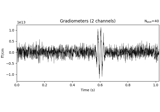mne.time_frequency.tfr_stockwell#
- mne.time_frequency.tfr_stockwell(inst, fmin=None, fmax=None, n_fft=None, width=1.0, decim=1, return_itc=False, n_jobs=None, verbose=None)[source]#
Warning
LEGACY: New code should use .compute_tfr(method=”stockwell”, freqs=”auto”).
Compute Time-Frequency Representation (TFR) using Stockwell Transform.
Same computation as
tfr_array_stockwell, but operates onEpochsobjects instead ofNumPy arrays.See [1][2][3][4] for more information.
- Parameters:
- inst
Epochs|Evoked The epochs or evoked object.
- fmin
None,float The minimum frequency to include. If None defaults to the minimum fft frequency greater than zero.
- fmax
None,float The maximum frequency to include. If None defaults to the maximum fft.
- n_fft
int|None The length of the windows used for FFT. If None, it defaults to the next power of 2 larger than the signal length.
- width
float The width of the Gaussian window. If < 1, increased temporal resolution, if > 1, increased frequency resolution. Defaults to 1. (classical S-Transform).
- decim
int The decimation factor on the time axis. To reduce memory usage.
- return_itcbool
Return intertrial coherence (ITC) as well as averaged power.
- n_jobs
int The number of jobs to run in parallel (over channels).
- verbosebool |
str|int|None Control verbosity of the logging output. If
None, use the default verbosity level. See the logging documentation andmne.verbose()for details. Should only be passed as a keyword argument.
- inst
- Returns:
- power
AverageTFR The averaged power.
- itc
AverageTFR The intertrial coherence. Only returned if return_itc is True.
- power
See also
Notes
New in v0.9.0.
References
Examples using mne.time_frequency.tfr_stockwell#

Time-frequency on simulated data (Multitaper vs. Morlet vs. Stockwell vs. Hilbert)